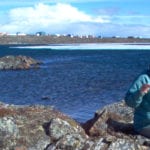Predicting when and where landslides could occur is imperative for the safety of Canadians, integrity of infrastructure, and safeguarding of natural resources. A diverse set of tools exist to accomplish this task but these tools are not without limitations.
Scott McDougall published a review in the Canadian Geotechnical Journal describing the state-of-practice in landslide runout analysis. He shared details from his free access review with CSP.
You study landslides and related geological processes. What’s so interesting about these processes to you, and how important are they in Canada?
All types of landslides are interesting and important in their own ways, but extremely rapid landslides—the kind you can’t outrun—are fascinating to me. Some of them are so large and travel so far you have to see them with your own eyes to believe they are possible, and even then your sense of scale becomes distorted. I recently took a group of students to see the Hope Slide, a rock avalanche that occurred about 150 km east of Vancouver, British Columbia, in 1965. The Hope Slide deposit has a volume of about 50 million m3, roughly enough material to fill the inside of BC Place Stadium—where the BC Lions and Vancouver Whitecaps play—about 20 times over.
These kinds of events are rare, but their improbability is also one of the things that makes them dangerous. Thousands of people are killed around the world by landslides every year, many of them in their own homes and in areas that are not necessarily located on, or even very close to, a steep slope. Fortunately, landslide deaths are relatively rare in Canada, but ongoing residential development pressure in our landslide-prone areas still makes this an important issue. Arguably just as important to us is effectively managing the economic and environmental risks that may be created when resource development—including mines and pipelines—occurs in these landslide-prone areas.

A view of the source of the 1965 Hope Slide, about two hours east of Vancouver, B.C.
What was the motivation behind your recent review paper in the Canadian Geotechnical Journal?
The paper originated as the Colloquium Lecture at the Canadian Geotechnical Society’s (CGS) annual conference in 2014. The Colloquium is an annual work commissioned by the Canadian Foundation for Geotechnique to highlight a topic of special interest to the Canadian geotechnical community. It was a great opportunity and experience for me.
I originally developed the lecture from my perspective as a consulting engineer at the time, after years of working on projects involving these kinds of long-runout landslides. In that context, the paper reflects some of my frustration with the limited tools and guidance that are currently available to practitioners to effectively forecast how far and how fast a landslide may travel, and how much damage it may cause. I moved from consulting to academia last year, so now I have to put my money where my mouth is! The challenges that are highlighted in the article have actually become the building blocks of my new research program at the University of British Columbia.
You use computer models to simulate landslides, and you say that the biggest challenge is choosing the right set of parameters to put into a model. Why is that the case?
Landslides are so diverse and complex. Researchers around the world are still working hard to understand what controls their behaviour. But even if we already did understand all of the underlying physics of a landslide, natural variability would still be a big factor to consider when making predictions. For example, a landslide may behave much differently if it occurs in a dry or a wet season or if its path happens to be covered in snow for part of the year. The parameters (and their ranges) we put into models need to somehow account for this uncertainty and variability, and the ranges of results we obtain need to be communicated clearly to the public and decision makers. I think we can learn a lot from weather forecasters, who are very experienced with handling uncertainty and communicating their results in terms of probabilities.

A computer simulation of a large landslide that occurred in southwestern B.C. in 2010.
You also mention integrating the use of video game engines in landslide analysis. How important is multidisciplinary collaboration in this field of research?
I think it’s really important. Having a variety of expertise and perspectives helps us tackle the complexity of landslides. As an engineer, I’m lucky to work in a university department where I’m surrounded by world-class earth scientists. Three new researchers are starting work in my group this year: a geographer, a physicist, and an engineer. We’ll be working closely with computer scientists, and also with planners and communication experts, to develop landslide forecasting tools that can be used effectively to improve land use decisions and engineering designs and ultimately reduce landslide-related losses.
I think the Canadian geotechnical community, as a whole, also thrives on this multidisciplinary approach. The CGS’s Geohazards Committee—formerly called the Landslides Committee, but recently renamed to reflect broader interests—is organizing the 7th Canadian Geohazards Conference next summer in Canmore, Alberta. The goal is to bring geohazards experts together from a wide variety of disciplines to exchange experiences and ideas.
What would you recommend to a student or an early career professional who wants to learn more about runout analysis or landslide risk management in general?
Right now it’s still somewhat of a specialized field, but I see it being used more and more as part of routine practice. There are several strong geological engineering and engineering geology undergraduate and graduate programs across Canada that cover these topics. I didn’t know these programs existed back when I was picking my own major (civil engineering). For shorter-term professional development, I hope to start offering short courses, either at conferences or through provincial engineering/geoscience associations. Drop me a line for updates!




